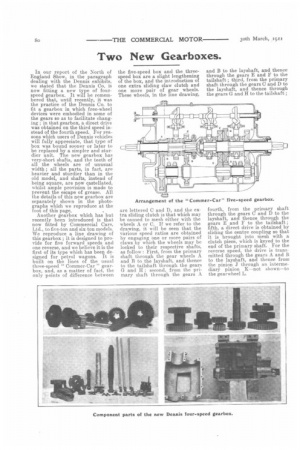Two New Gearboxes.
Page 12

Page 13

If you've noticed an error in this article please click here to report it so we can fix it.
In our report of the North of England Show, in the paragraph dealing with the Dennis exhibits, we stated that the Dennis Co. is now fitting a new type of fourspeed gearbox. It will be remembered that, until recently, it was the practice of the Dennis Co. to fit a gearbox in which free-wheel devices were embodied in some of the gears so as to facilitate changing; in that gearbox, a direct drive was obtained on the third speed instead of the fourth speed. For reasons which users of Dennis vehicles will fully appreciate, that type of box was bound sooner or later to be replaced by a simpler and sturdier unit. The new gearbox has very-short shafts, and the teeth of all the wheels are of unusual width ; all the parts, in fact, are heavier and sturdier than in the old model, and shafts, instead of being square, are now castellated, whilst ample provision is made to prevent the escape of grease. All the details of this new gearbox are separately shown in the photographs which we reproduce at the foot of this page. Another gearbox which has but recently been introduced is that now fitted by Commercial Cars, Ltd., to five-ton and six-ton models. We reproduce a line drawing of this gearbox ; it is designed to provide for five forward speeds and one reverse, and we believe it is the first of its type which has been designed for petrol wagons. It is built on the lines of the usual three-speed " Commer-Car " gearbox, and, as a matter of fact, the only points of difference between
the five-speed box and the threespeed box are a slight lengthening of the box, and the introduction of one extra sliding claw clutch and one more pair of gear wheels. These wheels, in the line drawing, are lettered C and D, and the extra sliding clutch is that which may be caused to mesh either with the wheels A or C. If we refer to the drawing, it will be seen that the various speed ratios are obtained by engaging one or more pairs of claws by which the wheels may be locked to their respective shafts, as follow : First, from the primary shaft through the gear wheels A and B to the layshaft, and thence to the tailshaft through the gears
and Ii; second, from the primary shaft through the gears A
and B to the layshaft, and thence through the gears E and F to the tailshaft ; third, from the primary shaft through the gears C and D to the layshaft, and thence through the gears 0 and H to the tailshaft ; fourth, from the primary shaft through the gears C and D to the layshaft, and thence through the gears E and F to the tailshaft ; fifth, a direct drive is obtained by sliding the centre coupling so that it is brought into mesh with a clutch piece, which is keyed to the end of the primary shaft. For the reverse speed, the drive is transmitted through the gears A and B to the layshaft, and thence from the pinion J through an intermediary pinion K—not shown—to the gearwheel L. The company has introduced this gearbox so as to provide an extra low speed which will enable a van o act as a tractor, that may, in addition to carrying a load on its own platform, haul a trailer loaded
with four tons ; the ratio of the first speed thus provided is low enough to insure that this load may be taken up any hill on main roads or second-class roads throughout the Kingdom. We illustrate, at the
foot of page 77 a five-ton " Cornmer-Car " van or W. J. Push and Co.,. Ltd., manufacturing chemists, of Hackney, in the chassis of which van one of the new five-speed gearboxes is embodied.




















